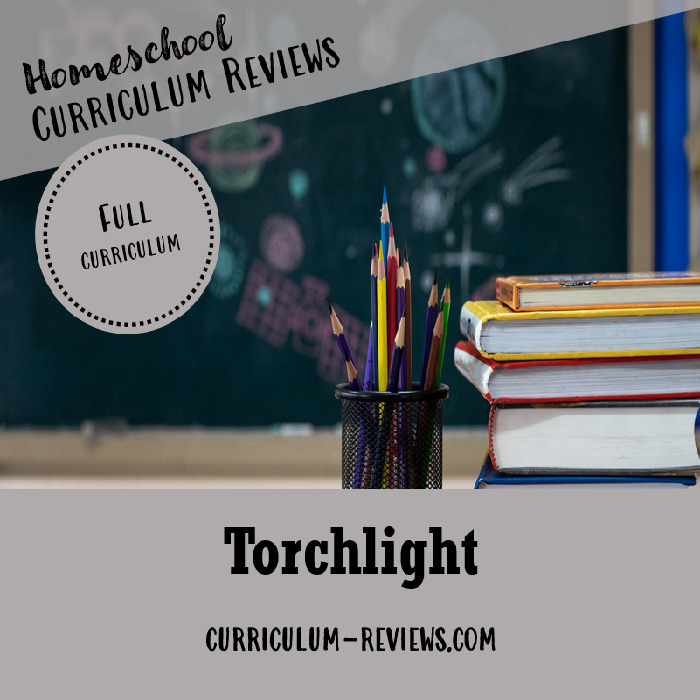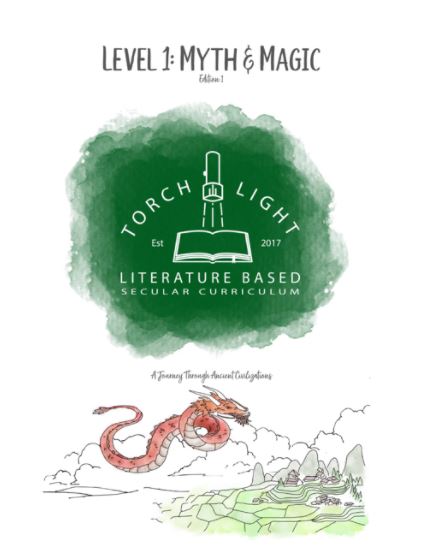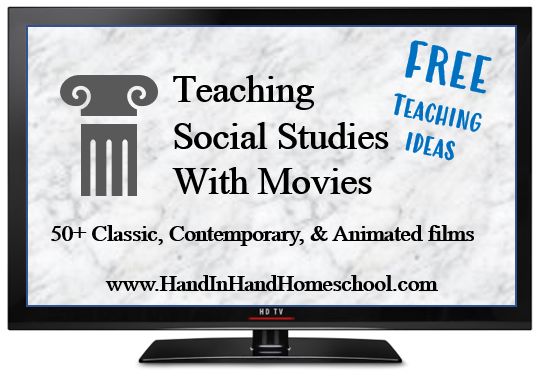
Torchlight

NOTE: A free placement tool is available on the Torchlight website to help families determine which level might work best for their children. The themes of the Torchlight levels and the suggested age range are as follows:
- Pre-K: Curiosity & Character (ages 4-5)
- K: Worldly Wisdom (ages 5-7)
- 1: Myth & Magic (ages 6-8)
- 2: Logic & Legend (ages 7-9)
- 3: Inquiry & Innovation (ages 8-12)
- 4: Ideas & Identity (ages 9-13)
- 5: Equity & Ethic (ages 10-15)
Torchlight is a secular literature-based curriculum that intentionally includes the contributions of diverse people and cultures around the world. Within each level, history/social studies, science, literature, art, and music are woven together into one overarching theme. The spirit of discovery and the importance of critical thinking skills are recurring motifs throughout the levels.
Torchlight would most appeal to homeschooling families whose children enjoy being read to. Even though the curriculum includes suggestions for games and links to videos related to the concepts being covered, the major focus is on reading parts of several books every day. While the lists of books used in each level is available for free on the website, it is well worth purchasing the curriculum to have the readings scheduled out in a logical order.
Each Torchlight level is intended to be used for a full school year. Levels K through 5 have assignments scheduled 5 days a week for 36 weeks, while PreK provides activities for 4 days per week for 32 weeks. The time required per lesson varies depending on the subject and the material. An average single day might involve reading a couple of chapters from the literature selection, reading a picture book or watching a video on the science topic and the history topic for the week, and listening to a music selection or creating an art project. It takes approximately an hour to an hour and a half to complete the scheduled assignments on an average day, though some science and art projects involve a longer time commitment.
This curriculum works best for parents who enjoy reading aloud with their children and have access to a well-stocked public library. Torchlight provides an excellent organizational tool in the form of a weekly schedule with blank spaces for other subjects such as math. However, the parent will have to ensure that they have gotten the required books and supplies needed for that week. Therefore, the parent should read the weekly schedule ahead of time to stay on top of gathering the books and supplies.
The main component of Torchlight is a reading list and associated activities and videos, broken down into weekly schedules and daily assignments. Families will have to obtain the scheduled books, either by borrowing them from the library or by purchasing them. Many books are only used for a short while, one day to 2-3 weeks, so you probably would not want to buy them all. Others are used most weeks throughout the year, so owning those books might be more convenient. Torchlight has a very active Facebook group for buying and reselling the books between families.
All of the required books are listed at the beginning of the curriculum, along with notations indicating whether they are a “spine” (used throughout the year) or a short-term read. In each weekly overview, other supplies for art or science projects are also listed. In order to assist in planning library holds and book purchases, there is a weekly breakdown of the books in the “member resources” on the main Torchlight website. You will have access to those additional resources once you have purchased a level of Torchlight.
For many of the history and science topics, Torchlight offers suggestions for videos and websites that reinforce concepts covered by the books. On average, that amounts to about 2-4 links per week. Since websites are continuously changing, occasionally you will encounter a dead link. However, since Torchlight was written relatively recently, this frustration happens less often than with other similar curricula. Torchlight also provides the title of videos, so if the link is no longer accurate, you can often find the video just by searching for the title. There is also a very active community of Torchlight users in the Facebook group for the curriculum, so it is easy to find help from others who have found supplemental internet resources or alternate books.
Parent-led instruction is required to get the most benefit from Torchlight. The curriculum is focused around reading to or with your child and discussing what has been read. While older children may be able to read many of the books on their own, the student would be missing out on a critical experience of this curriculum if the parent is not familiar with the material the child has read.
Assessment of learning is done through Socratic discussion and art projects. The literature primer in each level provides specific discussion points for sections of the book. There are also generic questions provided that can be used throughout the year for other readings. The questions are open-ended, so there is no answer key with correct solutions. In some levels and some weeks, there are art projects where the student can represent their learning through activities like drawing a comic strip. Again, these assignments are open-ended without a grading rubric.
Most levels include at least two year-long projects. One is a storytelling project that relates to the theme of the level. It includes a weekly prompt to which the child, along with their learning partner (as Torchlight calls the parent) makes up a creative story. The other project is a vocabulary book in which students define and use unfamiliar words they encounter during the literature readings. Suggested vocabulary is given in the literature primer but it is a very flexible project.
The flexibility of Torchlight allows families to use one level with several children of different ages. Additional reading options and videos are provided for older or more advanced students to delve deeper into the topics. All of the written assignments and discussions are open-ended and encourage critical thinking, so families can easily raise or lower the level to the needs of the learner. The writing assignments can be dictated to the parent rather than written out by the student, if needed. Nothing is lost from the overall enjoyment of the curriculum if some of the writing projects are skipped altogether, either.
Since the readings are intended to be done aloud, a student’s independent reading ability is not expected to align with most of the books in each level. In the earlier levels, some “easy reader” books are included for some science and history topics, but no expectation is placed on the child to have to read these books independently.
 About the Curriculum Author: Tiffany Petty is a home-educator with a background as an Education & Marketing Director. In her professional capacity, serving on curriculum boards, she realized that she wanted to enable students to connect important skills with a love for learning by using diverse materials. In the continual development of Torchlight, she seeks to support progress and great authors.
About the Curriculum Author: Tiffany Petty is a home-educator with a background as an Education & Marketing Director. In her professional capacity, serving on curriculum boards, she realized that she wanted to enable students to connect important skills with a love for learning by using diverse materials. In the continual development of Torchlight, she seeks to support progress and great authors.
Date of Review: April 2022

